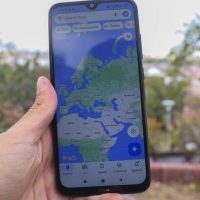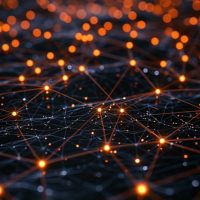In the turbulent times of the COVID-19 pandemic, all technologies are put on the frontline of the antivirus fight, and computer vision is no exception. But how exactly does computer vision software contribute to beating the virus? We’ll explore the matter in detail.
Effective prevention
Well-trained computer vision algorithms may help detect virus-specific abnormalities at a country’s entry points — large airports and ports, railway stations, and so on. In this case, the software monitors travelers to detect suspicious respiratory patterns and fever.
Computer vision technology has helped Taiwan, the country located close to the virus hotbed, to nip the aggressive COVID-19 dissemination in the bud. AI-driven infrared cameras have been monitoring travelers in major airports and sending the data to a powerful industrial GPU device that hosted the ML algorithms for further processing. Thanks to this computer vision system, Taiwan has managed to contain the virus spread. As of December 2, 2020, the nation has reported 651 COVID-19 cases and 7 deaths since the beginning of the pandemic.
AI-powered infrared cameras can make part of prevention mechanisms not only nationally but also locally. At the Albert Einstein Jewish Hospital (São Paulo, Brazil), a cam checks visitors’ temperature at the hospital front desk. In case a fever is detected, the connected system sends an alert to the chief nurse’s mobile device. The nurse puts the accepted triage protocol in motion and isolates the visitor if deemed necessary for the spread prevention. Due to efficient performance, the software is to be delivered to field hospitals across the country.
SEE ALSO: How to Build a Chatbot – All You Need to Know
Scaled-up diagnostics
The two key diagnostic methods for COVID-19 detection are computer tomography (CT) and chest radiography. Computer vision algorithms have already proved efficient for both.
Computer tomography is considered one of the most efficient diagnostic methods for COVID-19 detection. However, manual CT scan analysis takes time, which may cost lives in the present turmoil. Trying to mitigate the situation, Chinese researchers took up the challenge and developed deep learning models able to segment infected areas when analyzing CT scans from healthy and COVID-19 positive patients. A set of manual CT scan analyses done by professional radiologists served as a model benchmark. When the model reached high accuracy, it was deployed at the Wuhan University Renmin Hospital and made open-source for swifter diagnostics of new cases at affected locations worldwide.
Computer vision may assist not only in the coronavirus detection but also with diagnosing a COVID-19-related pneumonia. In this regard, it may even outdo qualified radiologists. Chinese specialists created an ML-driven system analyzing patients’ clinical data (age, sex, and more) and CT scans. When the researchers compared the system performance with that of professional radiologists, a surprising detail came out. The combined model managed to detect COVID-19 infection in about 70% of patients whose CTs were flagged as normal by medical experts. This fact allows us to suggest that deep learning models have the potential to identify complex patterns that go unnoticed by the human eye, however qualified.
Though CT is a valuable diagnostic method, its use has some disadvantages. First of all, it’s the radiation patients are exposed to. What’s more, it’s costly, which may hamper its availability in remote and rural areas. Here, the chest radiography may be a safer and more cost-efficient option.
Initially, automated solutions that analyzed X-ray images couldn’t detect the coronavirus per se. Still, they proved successful in analyzing the three types of pneumonia and identifying the one typically caused by the coronavirus. However, the situation has changed by now. DarwinAI has partnered with Red Hat to fine-tune a whole suite of deep neural networks to detect the coronavirus in chest X-rays. Their tools can stratify the results by disease progression and severity and have finally proved valid, so now they are to be deployed to various healthcare facilities. Moreover, the suite is open-source and available to clinicians and researchers worldwide.
When applied in diagnostics, computer vision delivers quality results in the shortest time possible. This allows clinicians to save time and effort on manual scan analysis and concentrate on providing suitable treatments.
Intelligent monitoring & surveillance
With the virus spreading around the world, the World Health Organization developed guidelines aimed at reducing its spread, such wearing personal protective equipment and maintaining social distancing. Computer vision has proved efficient for monitoring and tracking the guideline violations, and many Asian countries followed the lead to improve surveillance and monitoring with the power of ML.
At the beginning, computer vision logic for such monitoring was quite straightforward. Say, the guidelines say individuals should wear a protective mask whenever they are in a public place and ML models were to detect just that. With time, however, computer vision solutions for COVID-19 control have grown more sophisticated. For instance, a solution by RayReach Technologies makes use of CCTV camera frames to monitor and track a whole range of guideline violations, from crowding and the absence of masks to insufficient sanitizer use. If the deep learning model spots a violation, it sends alerts to dedicated CCTV surveillance teams. This helps fix violations timely.
Ensuring adherence to guidelines is not the only way to stop the coronavirus spread. A group of Malaysian researchers offered a solution: computer vision software installed in cameras by the entrances to shopping malls, banks, and other public places to ensure uninterrupted monitoring. The neural networks check visitors for following guidelines as well as for any COVID-19 symptom (fever, coughing, etc.), and then breaks visitors into High Alert, Keep Distance, and Safe groups. If the system decides a visitor presents a risk, it notifies them and a doctor. Researchers believe this solution will help the government ensure continuous monitoring in public places and improve control over the virus spread.
SEE ALSO: Machine learning in finance: From buzzword to mainstream
Summing up
As we can see, computer vision software has a lot to offer for fighting the pandemic. First of all, it helps doctors save time on manual diagnostic methods and deliver suitable treatments without delay. What’s more, machine learning models may detect trends and patterns that escape the human eye, even that of professionals. The technology has also proved efficient for virus spread prevention and monitoring. In this context, computer vision can be used at local, municipal, regional, national and even international levels. This may ensure effective virus spread control provided that the global level of cooperation remains at the present large scale.
The post Computer vision in the fight against the COVID-19 pandemic appeared first on JAXenter.
Source : JAXenter


















